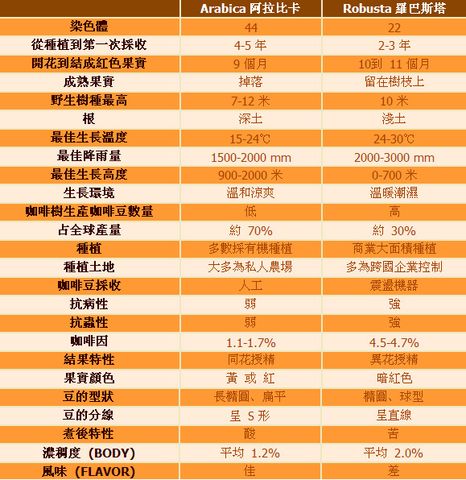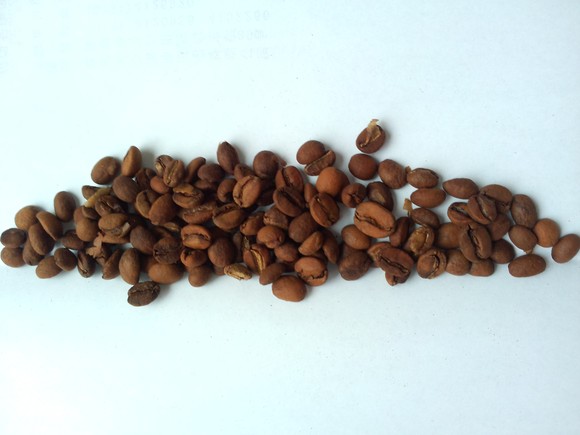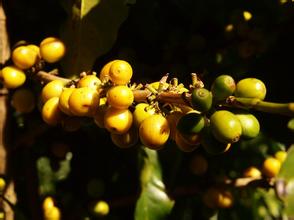The difference between Arabica and Rubusta
Arabica coffee
(transferred from www.molinarichina.com)
Arabica coffee (Coffee.Arabica): also known as Arabica coffee, its taxonomic position was determined by Linnaeus in 1753. It can produce Arabica coffee (C.Arabica) beans, which can be called high-quality coffee beans in the world and the only coffee that can be drunk without any ingredients.
The two best varieties of Arabica coffee (C.Arabica) are C.Typica and C.Burbon, but other varieties have also developed well. These include C.Caturra coffee grown in Brazil and Colombia, C.Mundo coffee from Brazil, C.Tico coffee widely grown in Central America and the famous Jamaican Blue Mountain Coffee (Jumaican C. Blue Mountain).
Arabica coffee (C.Arabica) trees are suitable for growing in countries with alpine terrain between the Tropic of Cancer and the Tropic of Cancer at an altitude of about 1000 meters above sea level. They grow on fertile hillsides with good drainage and require adequate sunshine and continuous rainy season and abundant rainfall. The temperature is 15 to 24 degrees seasonal, the temperature is mild but not very hot during the day, and less than two hours of direct sunshine. So farmers usually plant a lot of taller trees of similar varieties in coffee circles to shade. The temperature at night is about 15 degrees. If the temperature is too high, the coffee berries will grow too fast to produce small, strong, hard and high-quality Arabica coffee (C.Arabica). If it is too low and frost, it will freeze to death.
Arabica coffee (C.Arabica) trees are usually larger shrubs with green, oval leaves and poor resistance to rust. Its life span varies from 20 to 30 years (depending on production conditions and nursing), and then it needs to be replanted, usually harvested once every 3 to 4 years, with oval fruit and two flat coffee beans with zigzag grooves and a bit of peanuts. If there's only one, it's called peaberry pea-shaped coffee beans. It accounts for about 70% of the world's total coffee production.
Roberta Coffee
Roberta Coffee (Coffee. Robustra): more precisely, C. canephora Robustra (C. canephora var. robusta), which produces beans from C. robusta, contains 2 to 3 times more caffeine than C.Arabica because of its poor taste and is often used as a supplement to the production of instant coffee and Arabica coffee (C.Arabica) by the large coffee industry.
C. Robustra trees can grow in lower mountains and prefer warm equatorial climates, with temperatures stable in the range of 24 degrees to 29 degrees. It has strong resistance to rust and high yield. C. Robustra is a sturdy shrub or small tree, more than 10 meters tall, but with shallow roots. The mature period is as long as 11 months, and the shape of the beans of C. Robustra is more round, the middle side of the fissure is a little swollen, and the groove is very straight, much like half a soybean. It mainly occurs in central and western Africa, throughout Southeast Asia and in the C. Conilon region of Brazil.

Important Notice :
前街咖啡 FrontStreet Coffee has moved to new addredd:
FrontStreet Coffee Address: 315,Donghua East Road,GuangZhou
Tel:020 38364473
- Prev

Flavor characteristics of Arica Coffee in Yega Coffee Bean producing area is Arica Coffee beans delicious
I have always believed that the beans of the Aricha line are the beans that can directly change the basic understanding of coffee for beginners and laymen. Can interpret the concept of coffee as fruit to the end. This is also what I gave Yega to people who drank single coffee for the first time when I had the opportunity.
- Next

Where do coffee beans usually come from?
[guide] the coffee we drink comes from the roasting and grinding of coffee beans, and all this is provided by magical coffee bars. The origin of this economic crop is in Yisuobi in Africa. It has been cultivated for more than 2000 years. At present, the main coffee producing areas in the world are Latin America, Africa and Africa. According to statistics, coffee is cultivated in 76 countries in the world, mainly from coffee.
Related
- Guji coffee producing area of Guji, Ethiopia: Humbela, Shakiso, Wulaga
- What is the most expensive variety of Qiloso in BOP multi-variety group?
- How to store the coffee beans bought home?
- Why are Yemeni coffee beans so rare now?
- Ethiopian Sidamo all Red Fruit Sun Sun Santa Vini Coffee beans
- SOE is mostly sour? What does it mean? Is it a single bean? what's the difference between it and Italian blending?
- Is Italian coffee beans suitable for making hand-brewed coffee?
- How to choose coffee beans when making cold coffee? What kind of coffee beans are suitable for making cold coffee?
- Just entered the pit to make coffee, what kind of coffee beans should be chosen?
- Can only Japan buy real Blue Mountain Coffee? What are authentic Jamaican Blue Mountain coffee beans?

